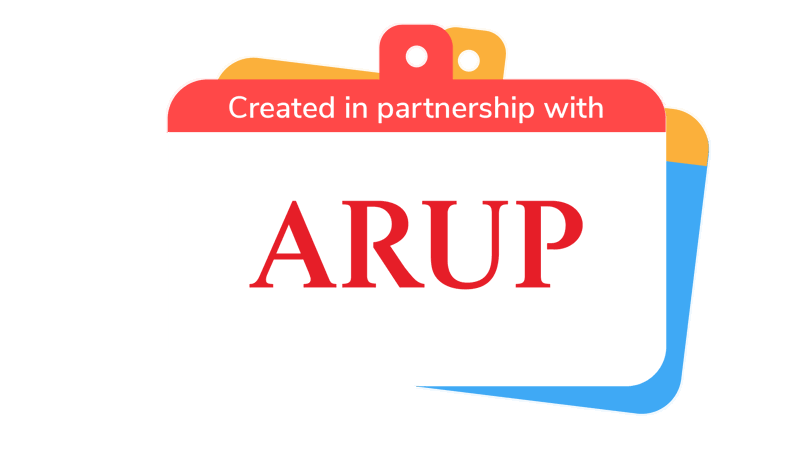
Mind the gap
You’ll need
- Chopsticks
- Masking tape
- Pioneering poles
- Rope
Before you begin
- Use the safety checklist to help you plan and risk assess your activity. Additional help to carry out your risk assessment, including examples can be found here. Don’t forget to make sure all young people and adults involved in the activity know how to take part safely.
- Check out our guidance for safe pioneering projects.
- Make sure everyone is wearing sturdy shoes and that the ground you’re building on is steady, level and presents no other hazards.
Setting up the activity
- Mark a gap on the floor with two lines. It needs to be about 1m longer than the longest pioneering pole you’re using.
Start the activity
- Gather everyone together.
- Explain that a raging river is running through the gap on the floor. The group’s task is to create a bridge. However, no part of the bridge or poles can be touching the ‘river’. The bridge needs be raised off the floor, so it’s not washed away by the raging river.
- The group should now split into two teams.
- Show everyone that the gap’s longer than their pioneering poles.
- Before starting, give the two teams a chance to discuss how they’ll create poles long enough to be able to cross the river and build the bridge. Each team should have access to chopsticks, paper, pens and tape to design and create a scale model of their bridge. Tell everyone they’ve 20 minutes to think about how they’ll build their bridge and to test out ideas.
- During the planning, encourage the group to think about how they’ll split their team into two groups to go on each side of the river. Who are the stronger knot tiers? How will they communicate effectively? Will there be a team leader on each side?
- Each team should now split into two groups, with one on each side of the river. Remind everyone they’ll be working together to create one bridge.
- Tell everyone that people may not cross the river once the activity has begun, so each group needs to stay behind their line on their side. You could add in a penalty, such as time being taken away, if people do cross the line to make it harder.
- Everyone should now start building their bridge.
- The first team to make a successful, free-standing bridge, which isn’t touching the river, wins! You could also give out prizes or congratulations to people who were good communicators, team players, effective leaders and helped motivate their team.
- To make it easier, the whole group could work as one team, rather than having a race between two teams. Success would then be achieved as soon as the bridge, and the challenge, is complete.
Moments and creating the strongest connection:
Needed the extra length but a single pole wasn’t long enough? You likely joined your pioneering poles together. If you did this you would just have one knot in the middle. By tying the poles so they overlap more, each knot has to be less strong, as the forces on it haven’t been increased through the effect of a lever.
Friction of ropes against the timber pioneering poles:
In this pioneering activity you have used ropes to tie together the pioneering poles. The knots you have used will rely on friction to prevent them from becoming undone. If they are too loose, you might have noticed that your bridge would be more wobbly!
In real life, what else needs to be considered for a bridge?
Some really big bridges you see will have suspension cables, these span across the bridge and allow for the longest spans on the planet. While the pylons (the big towers supporting the cables) are in compression and push into the ground, the cables tie into the ground at each end of the bridge and are in tension so they need a large anchor to keep them from coming out of the ground. This can be done using large masses of concrete, or connecting into the bedrock. (diagram shows red compression and blue tension). Tension is a force that stretches something. Compression is a force that squeezes something together.
When going over a bridge in day to day life, it’s probably a lot smother ride than what you have managed to make using just pioneering poles! This is because of the pavement design. On the bridge this may just be a thin coating, however the tricky bit is making sure that the road going onto and off the bridge consider the stiffness of the material underneath (both the ground its built on which can be quite soft, and the solid concrete or steel of the bridge itself). Without a transition between these surfaces, the pavement can break!
You might have noticed that on larger bridges there is a bump noise if you’re driving over it as you go on or off the bridge. This is because of special joints in the surface which allow for the bridge to expand and contract as its heated and cooled by the sun and weather. Without this the bridge would snap in cold weather as it shrinks or buckle in hot weather when it expands. You may have seen this in the news in really hot weather with railways tracks bending.
Reflection
This activity put your knot skills and teamwork to the test. Making a good plan and executing it well is key to being able to cross the raging torrent.
How did you work together to make sure all your lashings were tight enough to hold securely? This bridge would’ve been very difficult to build alone, without someone to hold together the parts you were lashing or to help pass parts across the gap.
Pioneering isn’t about speed. It’s about building something safe and useful. You can take your time and start again if you need to. If you were going to do this activity again, what would you do differently?
Safety
All activities must be safely managed. You must complete a thorough risk assessment and take appropriate steps to reduce risk. Use the safety checklist to help you plan and risk assess your activity. Always get approval for the activity, and have suitable supervision and an InTouch process.
- Poles and long objects
Be careful when moving poles or long items. Take care if the ends are sharp. Have appropriate supervision for this activity.
- Heavy and awkward objects
Never lift or move heavy or awkward items alone. Ask for help or, if possible, break them down into smaller parts.
- Outdoor activities
You must have permission to use the location. Always check the weather forecast, and inform parents and carers of any change in venue.
- Active games
The game area should be free of hazards. Explain the rules of the game clearly and have a clear way to communicate that the game must stop when needed. Take a look at our guidance on running active games safely.
- The gap needed to cross can be made smaller or larger to make it easier or harder.
- To make it harder, you could limit the number of resources available to make the bridges. You could also play loud music to simulate the noise of a raging river, or you could ask everyone to work silently to make it harder, too.
- To make this challenge easier, you could make a scaled down version of the challenge and run the task on a table. You could use chopsticks or skewers, with a gap marked on the table that’s double the length of the chopsticks or skewers. You could also have some inspiration images as prompts to make things easier. To make this version of the challenge harder, the bridge shouldn’t touch the table, be freestanding and be able to hold an item, such as a reusable plastic cup.
- If anyone needs help or struggles with fine motor skills, give them the opportunity to work in pairs, with a young leader or an adult volunteer. Additionally, someone could do other less physical roles, such as checking knots, or take role as team leader and direct the building.
- Think about the space you’ll be in and the equipment you’re using in advance to make sure it’s accessible to everyone in the group.
- It may be necessary to scale down your bridge to make building it possible for everyone.
All Scout activities should be inclusive and accessible.

